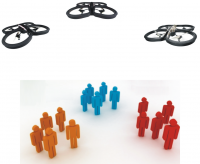Assistive autonomous UAVs

Robots that assist elderly or disabled persons in their day-to-day tasks can lead to a huge improvement in quality of life. This project employs UAVs to monitor at-risk persons, and research challenges range from real-time observation and observation to high-level vision and control for person monitoring. The project is appropriate for a team of students, each of them working on a well-defined subtask, such as:
- Acquiring high-precision position and orientation feedback from a system of indoor cameras. Once this is available, an extended Kalman filter or other nonlinear filter will be used for tracking and fusing camera feedback with information from the intertial measurement unit.
- Similar to the above, but this time outdoors to the position and orientation is acquired with lower-precision, but always available on-board cameras. Here, the highly nonlinear model of the drone can be used together with a homography mapping to translate the 3D dynamics of the drone into the 2D image frame, followed by fusion with IMU data as above.
- Control design to either navigate to a given sequence of positions, or track a dynamical trajectory. This can be done either with linear techniques in near-hovering mode, or using nonlinear, Takagi Sugeno design.
- Compensation of network effects for the control of the drone via the wireless connection
- Coordinated control of an outdoor team of UAVs using consensus, flocking, or formation control methods.
- Vision-based human following and monitoring for risks such as falls.
- Cooperative vision-based tracking of one or several at-risk humans.
The hardware used consists of five Parrot AR.Drone 2 UAVs, two Parrot Mambo Fly UAvs, and a system of four OptiTrack Flex13 cameras. Initial results, where an UAV tracks a human and detects whether they have fallen, are already available. This direction involves cooperations with the University of Dubrovnik, with the Politechnical University of Timisoara, and industry collaborator Polaris Medical.
Interested students should get in touch with any of the contact persons below to setup a meeting. Student skills that are interesting in this project range from fundamental math and control, through C++ and Matlab real-time coding, to high-level vision and planning using ROS.
